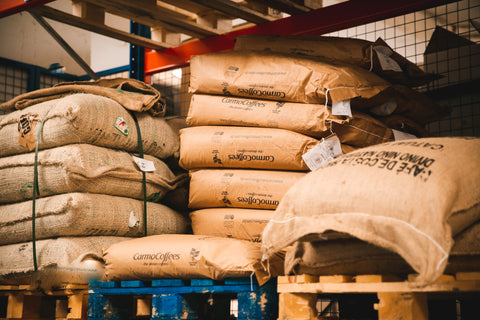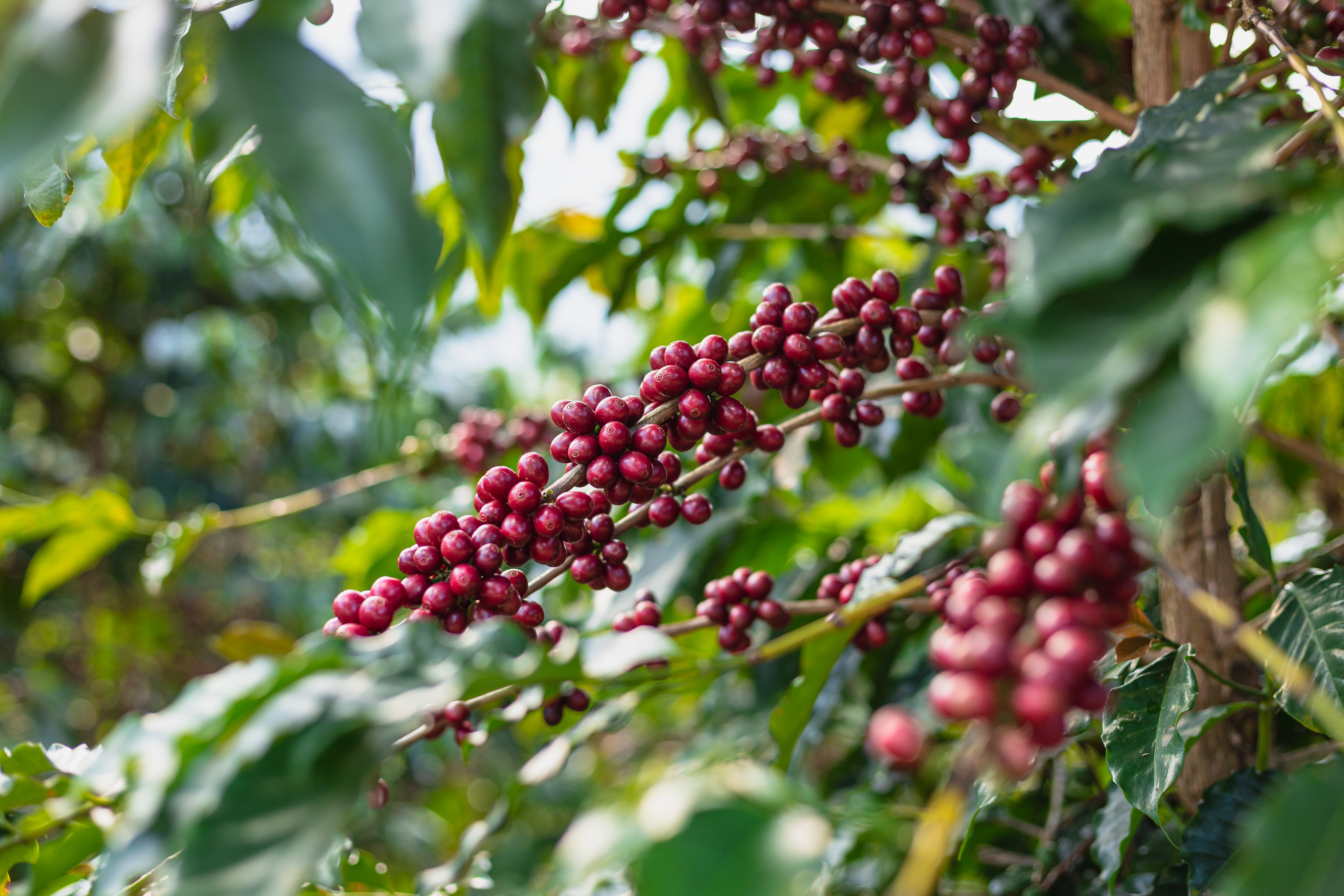Before coffee gets into the cup, it has to go a long way and go through various processes. Between coffee beans are planted, harvested and purchased, they go through a typical series of steps to get the best out of their coffee.
1. Planting
The coffee bean is actually the seed of a plant. When dried, roasted and artificially, it is used to make coffee. If the seed is not processed, it can be planted and then grow into a coffee tree. Coffee seeds are generally planted in large flower beds in shaded nurseries.
The seedlings are watered regularly and also protected from bright sunlight until they are strong enough to be permanently planted. Planting is often done during the rainy season, so that the soil remains moist, and thanks to these properties, the roots of the coffee tree can more easily penetrate the soil and sink firmly.

2. Harvesting coffee cherries
Depending on the variety, it takes about 3 to 4 years for newly planted coffee trees to bear their first fruits. The fruit, called the coffee cherry, turns bright, deep red or yellow (depending on the variety) when ripe and ready for harvest. They are usually harvested once a year.
In most regions, the crop is harvested by hand, although in places such as Brazil, where the landscape is relatively flat and the coffee fields are huge, this process has been mechanized. There are two ways to collect coffee.
First option is, plucking all the cherries from the branch at once. This collection can be done manually or by machine. Unfortunately, in this case, unripe cherries are also harvested.
Selective collection: Only ripe cherries are harvested, which are harvested individually and only by hand. The pickers rotate between the trees every 8 to 10 days and pick only cherries that are already ripe for harvest. Because this type of harvest is labor intensive and more expensive, it is mainly used to harvest finer Arabica grains.
A good collector collects on average about 40 to 80 kilos of coffee cherries per day, which produces 10 to 20 kilos of coffee beans. The daily collection of each worker is carefully considered and each collector is paid according to the merits for their work. The daily harvest is then transported to a processing plant.

3. Processing of coffee cherries
Once the coffee is harvested, processing must begin as soon as possible to prevent spoilage of the fruit. Depending on the location and local sources, coffee is processed in one of two ways:
Dry method is a method of coffee processing and is still used in many countries with limited water resources. Freshly picked cherries simply spread over huge areas to dry in the sun. In order not to spoil the cherries, they rake and turn during the day, and cover them at night or in the rain so that they do not get wet. Depending on the weather, this process can continue for several batches of coffee until the moisture content of the cherries drops to 11%.
Promyta methoda - it removes the pulp from the coffee cherry after harvest, so that the bean is dried only with parchment skin. First, freshly harvested cherries are passed through a pulping machine to separate the skin and flesh from the grain. The grains are then separated by weight as they pass through the water channels. Lighter grains float on the surface, while heavier ripe grains sink to the bottom. They go through a series of rotating drums, which separate them according to size.
After separation, the grains are transported to large fermentation tanks filled with water. Depending on a combination of factors - such as grain condition, climate and altitude - the grains will remain in these tanks for 12 to 48 hours to remove the slippery layer of mucus (so-called parenchyma) that is still attached to the parchment. During rest in tanks, naturally occurring enzymes cause this layer to dissolve.
After fermentation, the grains are rough to the touch. The grains are then rinsed with additional water channels and are ready to dry.

4. Drying of coffee beans
If the grains have been processed by the washed method, they must be dried to a moisture content of approximately 11% to be properly prepared for storage. The grains are spread out inside the parchment cover (endocarp) on drying beds (fabric construction) or terraces, where they are regularly turned and aerated. Another option is to use industrial dryers. Dried beans are known as parchment coffee and are stored in jute or sisal bags until ready for export.

5. Final grain cleaning
Prior to export, parchment coffee is processed as follows:
Peeling removes the parchment layer (endocarp) from the coffee processed by the washed method. Peeling coffee processed by the dry method means removing the entire dried skin - exocarp, mesocarp and endocarp - from the dried cherries.
Polishing is an optional process in which the silver husk that remains on the grains after peeling is removed by machine. Although polished grains are considered better than unpolished, there is really little difference between them.
Evaluation and classification is carried out according to size and weight, and color defects, defects or other imperfections are also checked for the grains.
The grains are sorted by passing through a series of sieves. It is also sorted pneumatically using an air nozzle to separate heavy and light grains.
Typically, the grain size is represented on a scale of 10 to 20. The number represents the size of the round hole diameter in 1/64 inch. The number 10 grains would be approximately the size of a 10/64 inch diameter hole and the number 15 15/64 inch grains.
Finally, defective grains are removed either manually or by machines. Grains that are unsatisfactory due to imperfections (unacceptable size or color, defects, pre-fermented grains, damaged by insects, unpeeled) are removed. This process ensures that only the highest quality coffee beans are exported.

6. Grain export
The beans, now referred to as "green coffee", are loaded onto ships in either jute or sisal bags in shipping containers. For quality coffees, the inner plastic packaging called "grain pro" is always used in the jute bag. This bag protects the grains from external influences during transport, prevents contamination and also maintains a relative microclimate.

7. Coffee tasting and evaluation
The coffee is then tested using green grading and cupping. First, the taster evaluates the coffee in terms of its overall visual quality, so it performs green grading. After this inspection, the grains are roasted and cupping is performed. The aroma of coffee is evaluated first. Then its very taste. Based on this evaluation, the cafes decide whether to put the coffee on sale or not. We will discuss cupping and green grading in more detail in other articles on ours blog.
8. Roasting coffee
By roasting, green coffee is transformed by heat into aromatic brown beans, which you buy from us at our e-shop or branches. The taste success in the roasting process of a given coffee depends on many factors such as: water activity, relative grain moisture, density, which may vary due to different processing method, variety type, altitude, etc. At Coffee Source, we roast our coffee ourselves and over the years of roasting and coffee in general, we have fine-tuned our own practices and now we are putting a lot on previous experience and our know-how.
The coffee roaster can be drum or air roasting, depending on the method of heat transfer (conduction or convection). The nature of this transmission can be changed by the number of revolutions of the drum per minute. Slower speeds mean approach to conduction, faster ones approach convection. The nature of the heat transfer can also be changed by the number and choice of material in the drum shell, including the way the heated air rotates inside it. At the roastery, the operator has the opportunity to change the amount of heat supplied (fully modulated burner) and heat removed (blower speed control). The grains must move throughout the roasting process so that they do not burn and roast evenly. When the grains reach an internal temperature of 170 - 190 degrees Celsius (depending on the position, type and accuracy of the temperature probes located on the roastery), the aroma and taste of the coffee begin to develop.
Each roaster has a different approach and way of roasting coffee.
After roasting, the grains are immediately cooled in the air in our roastery.

9. Grinding coffee
You may not have known, but whether the resulting cup of coffee will be good or not depends a lot on the method of grinding. How coarsely or finely we grind the coffee depends mainly on the way we made the coffee. The other roughness will be at the espresso machine, another at the V60 and another at the French press. In general, however, the finer the grind, the faster the coffee should be prepared. We grind coffee itself in this article.

10. Coffee preparation itself
And now we are in the last step of this long journey that coffee must take. So all that remains is to make coffee from ground beans and enjoy its taste and aroma in all its diversity. Taste for example one of of our coffees.





Share:
How to make a great DRIP at home
Labels for the packaging of our coffees